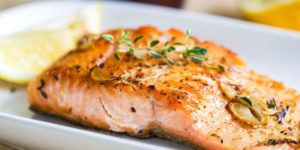Five Tips for Healthy Summer Eating
Summer months are a great time to focus on healthier eating patterns. We spend so much more time outdoors being physically active which means less time wandering around our pantries looking for food to eat when we’re not really that hungry. Grocery stores and local veggie/fruit stands are brimming with fresh produce just waiting for us to enjoy. And outdoor grilling offers a more healthy way to prepare our food. I LOVE SUMMER! Make this one of your healthiest summers by setting a few goals. Here are five to get you started.
 1. Take Advantage of Fresh Produce
1. Take Advantage of Fresh Produce
With produce at its peak during the summer months, now is the perfect time to indulge in fresh vegetables and fruit. Fill half your plate with salads, grilled veggies, fresh fruit etc.
Veggies:
- Tomatoes: Slicing one cup of raw tomato for your lunch salad gives you as much as 40 percent of your recommended daily intake of vitamin C and 20 percent of your daily vitamin A.
- Avocados: find their way into salads, dressings and on top of burgers regularly, so it’s a good thing that they’re full of fiber, vitamins B5, B6, C, K, folate and potassium, as well as cell-protecting antioxidants.
- Greens: Beet greens, dandelion greens, spinach, lettuce and Swiss chard are all in season throughout the spring and summer months. These greens contain protein and iron, and are full of the cell-protecting and repairing antioxidants, vitamins C and A, as well as B vitamins and fiber. Toss them into a blender, along with some fresh fruit for a green smoothie.
- Bell peppers: make a colorful addition to a snack, salad or meal, and they contain phytochemicals called carotenoids, which give them their bright colors and are associated with reducing the risk of developing cardiovascular disease, and age-related eye diseases.
You might enjoy Chicken Avocado Caprese Salad, Simple Green Smoothie, Grilled Zucchini with Garlic Lemon Baste
Fruits:
When choosing fruits, always make sure to buy the freshest, best quality.
- Berries: Though each tasty variety of berry has its own unique nutritional values and functional benefits, all berries are high in antioxidants, fiber and vitamin C.
- Watermelon:has the highest concentration of lycopene of any fresh fruit or vegetable, so indulge in this sweet fruit throughout the summer months.
- Peaches and Nectarines: At roughly 70 calories for a large peach, these fruits contain fiber, antioxidants to deter chronic diseases and reduce body inflammation, potassium, vitamin C and A.
You might enjoy Simple Purple Protein Smoothie, Mixed Fruit Salad with Lime and Mint
 2. Choose Lean Meats
2. Choose Lean Meats
Healthy meat alternatives include ground turkey and skinless chicken breasts. Grill salmon, tuna, trout or flounder for a low-calorie, protein-packed lunch or dinner. Limit red meat to just a few times a month. Top meats, poultry and fish with fresh salsas, guacamole or grilled pineapple rather than cheese or high-calorie sauces. Fill 1/4 of your plate with protein. You might enjoy Spicy Chipotle Grilled Turkey Burgers, Strawberry Avocado Salad with Honey-Glazed Grilled Salmon
 3. Be Smart About Frozen Sweet Treats
3. Be Smart About Frozen Sweet Treats
To satisfy your sweet tooth look for healthier alternatives to the typical calorie-laden summer treats like premium ice creams or gelatos. Buy low-fat, low-sugar versions or freeze your own lower calorie ice creams, sorbets and yogurts. You might enjoy Watermelon Sorbet, Fresh Strawberry Ice Cream, Tropical Strawberry Frozen Yogurt
 4. Stay Hydrated
4. Stay Hydrated
With scorching hot temperatures and outdoor activities ramping up, dehydration is a major concern. To stay hydrated during the summer, buy a reusable water bottle and keep it with you all the time as a reminder to take sips regularly. Drink at least half your body weight (lbs) in ounces every day. Read more about the Importance of Hydration.
 5. Eat Smaller, Lighter Meals
5. Eat Smaller, Lighter Meals
We tend to be much more active during the summer months. To give your digestion a break, aim to eat smaller and lighter meals spread out throughout the day. This way you will have much more energy and won’t feel bloated and weighed down! Practice eating mindfully; this means paying attention to why you’re eating. Eat for reasons that have to do with being hungry, rather than as a response to a non-hunger cue. Read more about How to Listen to your Cues of Hunger and Fullness and a Guideline for What to Eat.



LeAnn Gelskey
Thanks Karen! Also, I’m really missing your weekly menus. I hope that you will continue to post them as they are very helpful. Enjoy the summer!
Karen
Hi LeAnn. This is very helpful to know that you are interested in the weekly menus. I’m taking a break over the summer to focus on a new project coming soon, but will resume in the fall. Thank you for your feedback.